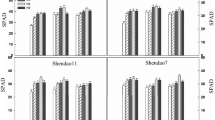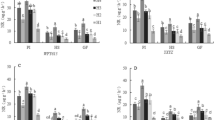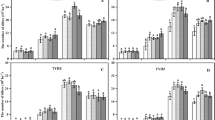Abstract
Topdressing at panicle differentiation (PF) according to soil fertility and regularity of rice nutrient absorption is an important agronomic practice used in cultivation of rice cultivars with a long growth duration. We studied the impacts of timing of nitrogen fertilizer application during PF on photosynthesis and yield-related agronomic traits in ‘Y-Liang-You 900’ and ‘Y-Liang-You 6’, which are representative rice cultivars with a long growth duration. Data for two years showed that timing of topdressing application during PF affected panicles per unit area, percentage grain set, spikelets per panicle, and leaf photosynthetic traits during the grain-filling period. Topdressing at the initial stage of flag-leaf extension resulted in higher grain yield (typically by 10.55–19.95%) than in plants without topdressing. Grain yield was significantly correlated with flag leaf photosynthetic rate and leaf SPAD value (r = 0.5640 and r = 0.5589, respectively; p < 0.01) at an advanced grain-filling stage (30 days after heading). Surprisingly, grain yield was not correlated with carbohydrate remobilization from the stem and sheath. For rice cultivars with a long growth duration, nitrogen-fertilizer topdressing must be applied at the initial stage of flag-leaf extension to delay leaf senescence during the grain-filling stage and realize the enhanced yield potential.
Similar content being viewed by others
Introduction
Rice (Oryza sativa L.) is a staple food for more than one-third of the global population1,2. Rice grain yield is required to increase by more than 1% annually to meet the expected increase in demand as a result of continued population growth and decrease in available paddy area3,4,5. Breeding of high-yielding cultivars and determination of optimal agronomic practices for different cultivars are required to realize the required improvement in rice yield6. Actual grain yield is the product of the harvest index (HI) and biomass. The HI of many elite rice cultivars has already attained an extremely high value (above 0.5), thus further improvement of the yield potential is reliant on an increase in biomass7. This realization is already reflected in current rice breeding programs, in which genotypes with a long growth duration, characterized by a longer grain-filling period, are selected for greater biomass production and correspondingly higher grain yield at harvest, as exemplified by ‘Y-Liang-You 900’8,9,10. ‘Y-Liang-You 900’ differs from many rice cultivars, which typically have a growth duration of 110–120 days, in having a growth duration of more than 140 days11. This comparatively long growth duration necessitates development of novel field practices to realize the yield potential of such high-yielding rice lines in the field.
A number of field practices are now routinely used in modern rice cultivation, including promotion of germination in a seedbed, organic fertilizer application before transplanting, water management during the tillering stage, topdressing during the young panicle differentiation stage, and alternate wetting and drying during the grain-filling stage10,12. Among these practices, different topdressing schedules can differentially influence photosynthetic efficiency13 and panicle differentiation, thereby resulting in differences in panicle number per plant and number of seeds per panicle14,15,16, and the functional longevity of leaves during the grain-filling stage17,18,19.
The process of young panicle differentiation of rice can be divided into eight stages30,31. Preheading organic carbon storage in the stem and sheath can potentially contribute to as much as 30% of the grain yield in early-maturing rice cultivars32,33. The majority of these conclusions were drawn based on studies using rice cultivars with a shorter growth duration. In the present study, grain yield in YLY900 and YLY6 was not significantly correlated with either RRVO or CRVO (Fig. 4), which indicated that preheading reserves make a relatively minor contribution to grain yield of rice cultivars with a long grain-filling period. Instead, grain yield of YLY900 and YLY6 showed a significant positive correlation with the leaf SPAD value28. Interestingly, the Pearson correlation coefficients were increasingly higher and more strongly significant with progression of the developmental stage after heading (r = 0.2166 ns, r = 0.4219*, r = 0.5640** at the heading stage, 15 days after heading, and 30 days after heading, respectively; * p < 0.05, ** p < 0.01, ns = nonsignificant; Fig. 5). Consistent with previous observation that topdressing at the initial stage of flag-leaf extension resulted in the highest grain yield, the maximal significant correlation coefficient of 0.87 was observed at 15 days after heading (Fig. 6). These results suggested that rice cultivars with a long growth duration show novel characteristics, i.e., grain yield is strongly dependent on canopy photosynthetic CO2 uptake during the grain-filling stage, rather than organic carbon stored in the stem and sheath. Previous studies have estimated that during the grain-filling stage, canopy photosynthetic CO2 uptake may contribute 60–100% of the final grain yield of rice30,31 and more than 40% of canopy photosynthesis can be contributed by the flag leaves34. In the current study, on average, the contribution of canopy photosynthetic CO2 uptake to total grain yield formation in YLY900 and YLY6 was higher than 78% and 87%, respectively (Table 3), which was much higher than the percentages reported previously for other rice cultivars35.
Correlation analysis between grain yield and net photosynthetic rate (Pn) in the two years, two cultivars, and seven treatments. (A) Heading stage; (B) after heading 15 days; (C) after heading 30 days; (D) mean of three stages. * and ** indicates significant correlation between yield and Pn at P < 0.05 and 0.01, respectively.
Correlation analysis between grain yield and leaf SPAD value in the two years, two cultivars, and seven treatments. (A) Heading stage; (B) after heading 15 days; (C) after heading 30 days; (D) mean of three stages. * and ** indicates significant correlation between yield and SPAD at P < 0.05 and 0.01, respectively.
Conclusion
Compared with rice cultivars with a relatively shorter growth duration, topdressing must be applied at an appropriate stage of young panicle differentiation to realize the enhanced grain-yield potential of cultivars with a longer growth duration. Specifically, for the two cultivars tested in this study, topdressing at the initial stage of flag-leaf extension results in greater enhancement of grain yield, which is primarily contributed by the improved physiological activity of the flag leaves at the middle and advanced grain-filling stages. In contrast to earlier-maturing rice cultivars, in which remobilization of stored carbon in the stem and sheath contributes as much as 30–40% of the final grain yield, in YLY900 and YLY6 the photosynthetic CO2 uptake rate during the grain-filling stage contributed to more than 78%–87% of the final grain yield. The information provided in this study can be used to improve topdressing application for rice cultivars with a long growth duration.
References
Miao, Y. X., Stewart, B. A. & Zhang, F. S. Long-term experiments for sustainable nutrient management in China: a review. Agron. Sustain. Dev. 31(2), 397–414 (2011).
Abid, M. et al. Response of hybrid rice to various transplanting dates and nitrogen application rates. Philippine Agric. Sci. 98(1), 98–104 (2015).
Normile, D. Reinventing rice to feed the world. Science 321, 330–333 (2008).
Chen, J. et al. An evolutionarily conserved gene, FUWA, plays a role in determining panicle architecture, grain shape and grain weight in rice. Plant J. 83(3), 427–438 (2015).
Jiang, P., **e, X.B., Huang, M., et al. Potential yield increase of hybrid rice at five locations in southern China. Rice 9(1), 11 (2016).
Yuan, L. Breeding of super hybrid rice. International Rice Research Conference, Los Banos, Laguna (Philippines), 31 Mar-3 Apr IRRI (2001).
Yuan, L. P. Progress in super-hybrid rice breeding. Crop J. 5(2), 100–102 (2017).
Zhang, Y. B. et al. Yield potential and radiation use efficiency of “super” hybrid rice grown under subtropical conditions. Field Crops Res. 114(1), 91–98 (2009).
Huang, M. et al. Relationship between grain yield and yield components in super hybrid rice. Agric. Sci. China 10(10), 1537–1544 (2011).
Li, J.W., Zhang, Y.Z., Wu, J., Shu, Y.L., Zhou, P., Deng, Q.Y. High-yield cultural techniques of super hybrid rice YLY 900 yielded 15.40 t/hm2 on a 6.84 hm2 scale. China Rice. 20(6), 1–4 (2014).
Zhao, B. H., Wang, P., Zhang, H. X., Zhu, Q. S. & Yang, J. C. Source-sink and grain-filling characteristics of two-line hybrid rice Yangliangyou 6. Rice Sci. 13(1), 34–42 (2006).
He, X. E., Liu, Y., Teng, Z. N., Yang, J. & Zhang, Y. Z. Effects of application stage of panicle fertilizer on leaf photosynthetic characteristics and dry matter accumulation. Hunan Agric. Sci. 5, 10–13 (2017).
Jiang, Q. et al. Effects of panicle N fertilizer on caryopsis development and economic characters of super rice. J. Nan**g Agric. Univ. 39(2), 191–197 (2016).
Zhu, C. H. et al. Effects of different paddy field drainage degrees and panicle nitrogen fertilizer managements on yield and nitrogen utilization of different nitrogen efficiency hybrid rice. Chin. J. Rice Sci. 28(3), 258–266 (2014).
Chen J. M., Lu W.Y. Effects of panicle fertilizer on growth stage and yield of yongyou 15.China Rice. 22:96–97 (2016).
Gao, J., Chen, M.J. Effect of increasing panicle fertilizer on rice yield and nitrogen use efficiency. J. Northeast Agric. Sci. (2018).
Hua, C. & Wang, R. L. Changes of SOD and CAT activities and MDA content during senescence of hybrid rice and three lines leaves. Acta Bot. Boreali-occidentalia Sin. 23(3), 406–409 (2003).
Li, M. Y. et al. Effects of nitrogen application of panicle fertilizer on source-sink characteristics and nitrogen fertilizer use efficiency of super hybrid rice Ganxin 688. Hybrid Rice 2, 28 (2010).
Panda, D. & Sarkar, R. K. Natural leaf senescence: probed by chlorophyll fluorescence, CO2 photosynthetic rate and antioxidant enzyme activities during grain filling in different rice cultivars. Physiol. Mol. Biol. Plants 19(1), 43–51 (2013).
Chen, W., **e, B., Wang, W., Zhang, S. & Yu, B. Technologies for determinating the beginning of rice young panicle differentiation. Hubei Agric. Sci. 50(17), 3492–3494 (2011).
Ku, B. I. et al. Variation of panicle differentiation stage by leaf growth according to rice cultivars and transplanting time. Kor. J. Crop Sci. 58(4), 353–361 (2013).
Li, W. J., Guo, M., **a, Y. Q., Yang, X. Y. & Yan, X. Y. Effects of applying nitrogen fertilizer and fertilizer additive on rice yield and rice plant nitrogen uptake, translocation, and utilization. J. Appl. Ecol. 22(9), 1 (2011).
Yang, H. C., Wu, L. Q. & Han, X. F. Effects of different nitrogen fertilizer levels on lodging and yield of rice. Agric. Sci. Technol. 13(7), 1456–1459 (2012).
Yang, J. C. Approaches to achieve high grain yield and high resource use efficiency in rice. Front. Agric. Sci. Eng. 2(2), 115–123 (2015).
Duan, H., Liang, F., Ju, C., Liu, L. & Yang, J. Effects of application of nitrogen as panicle-promoting fertilizer on seed setting and grain quality of rice under high temperature stress. Chin. Rice Sci. 27(6), 591–602 (2013).
Zhang, H. et al. Performance in grain yield and physiological traits of rice in the Yangtze River Basin of China during the last 60 yr. J. Integr. Agric. 12(1), 57–66 (2013).
Li, J. et al. Construction and application effect of the leaf value model based on SPAD value in rice. Sci. Agric. Sin. 50(24), 4714–4724 (2017).
Yi, Q. et al. Yield and nitrogen use efficiency as influenced by real time and site specific nitrogen management in two rice cultivars. Plant Nutr. Fertil. Sci. 18(4), 777–785 (2012).
Ma, S., Wang, Y. & Tang, A. Variation of rice canopy SPAD value and chlorophyll, leaf nitrogen content and net photosynthetic rate. Sci. Technol. Eng. 24, 147–152 (2016).
Takai, T., Fukuta, Y., Shiraiwa, T. & Horie, T. Time-related map** of quantitative trait loci controlling grain-filling in rice (Oryza sativa L.). J. Exp. Bot. 56(418), 2107–2118 (2005).
Wang, Y. & Yu, J. Photosynthetic changes of flag leaves during senescence stage in super high-yield hybrid rice LYPJ grown in field condition. Plant Physiol. Biochem. 82, 194–201 (2014).
Wu, X., Zhang, W. & Wu, L. Characteristics of lodging resistance of super-hybrid indica rice and its response to nitrogen. Sci. Agric. Sin. 48(14), 2705–2717 (2015).
Zhang, J. et al. Effects of culm carbohydrate partitioning on basal stem strength in a high-yielding rice population. Crop J. 5(6), 478–487 (2017).
Basyouni, A., Abou-khalifa, A., Misra, A., Salem AE-AK. Effect of leaf cutting on physiological traits and yield of two rice cultivars. Afr. J. Plant Sci. 2, 147–150 (2008).
Song, Q. F., Zhang, G. & Zhu, X. G. Optimal crop canopy architecture to maximise canopy photosynthetic CO2 uptake under elevated CO2—a theoretical study using a mechanistic model of canopy photosynthesis. Funct. Plant Biol. 40(2), 108 (2013).
Yoshida, S. Fundamentals of rice crop science, M. The International Rice Research Institute (1981).
Acknowledgements
This research was financially supported by the National Key Research and Development Program of China (2018YFD0301000 and 2016YFD0300507) and the Natural Science Foundation of Hunan Province (2020JJ5315). We thank Robert McKenzie, PhD, from Liwen Bianji, Edanz Editing China (https://www.liwenbianji.cn/ac), for editing the English text of a draft of this manuscript.
Author information
Authors and Affiliations
Contributions
Y.Z. and H.Z. designed the experiment. Y.L., C.L., X.H. and S.C. performed the experiment. Y.L., X.Z. and T.C. wrote the paper. All authors reviewed the manuscript.
Corresponding authors
Ethics declarations
Competing interests
The authors declare no competing interests.
Additional information
Publisher's note
Springer Nature remains neutral with regard to jurisdictional claims in published maps and institutional affiliations.
Rights and permissions
Open Access This article is licensed under a Creative Commons Attribution 4.0 International License, which permits use, sharing, adaptation, distribution and reproduction in any medium or format, as long as you give appropriate credit to the original author(s) and the source, provide a link to the Creative Commons licence, and indicate if changes were made. The images or other third party material in this article are included in the article's Creative Commons licence, unless indicated otherwise in a credit line to the material. If material is not included in the article's Creative Commons licence and your intended use is not permitted by statutory regulation or exceeds the permitted use, you will need to obtain permission directly from the copyright holder. To view a copy of this licence, visit http://creativecommons.org/licenses/by/4.0/.
About this article
Cite this article
Liu, Y., Zhu, X., He, X. et al. Scheduling of nitrogen fertilizer topdressing during panicle differentiation to improve grain yield of rice with a long growth duration. Sci Rep 10, 15197 (2020). https://doi.org/10.1038/s41598-020-71983-y
Received:
Accepted:
Published:
DOI: https://doi.org/10.1038/s41598-020-71983-y
- Springer Nature Limited







